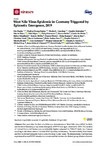West Nile Virus Epidemic in Germany Triggered by Epizootic Emergence, 2019
Ziegler, Ute
Santos, Pauline Dianne
Groschup, Martin H.
Hattendorf, Carolin
Eiden, Martin
Höper, Dirk
Eisermann, Philip
Keller, Markus
Michel, Friederike
Klopfleisch, Robert
Müller, Kerstin
Werner, Doreen
Kampen, Helge
Beer, Martin
Frank, Christina
Lachmann, Raskit
Tews, Birke Andrea
Wylezich, Claudia
Rinder, Monika
Lachmann, Lars
Grünewald, Thomas
Szentiks, Claudia A.
Sieg, Michael
Schmidt-Chanasit, Jonas
Cadar, Daniel
Lühken, Renke
One year after the first autochthonous transmission of West Nile virus (WNV) to birds and horses in Germany, an epizootic emergence of WNV was again observed in 2019. The number of infected birds and horses was considerably higher compared to 2018 (12 birds, two horses), resulting in the observation of the first WNV epidemy in Germany: 76 cases in birds, 36 in horses and five confirmed mosquito-borne, autochthonous human cases. We demonstrated that Germany experienced several WNV introduction events and that strains of a distinct group (Eastern German WNV clade), which was introduced to Germany as a single introduction event, dominated mosquito, birds, horse and human-related virus variants in 2018 and 2019. Virus strains in this clade are characterized by a specific-Lys2114Arg mutation, which might lead to an increase in viral fitness. Extraordinary high temperatures in 2018/2019 allowed a low extrinsic incubation period (EIP), which drove the epizootic emergence and, in the end, most likely triggered the 2019 epidemic. Spatiotemporal EIP values correlated with the geographical WNV incidence. This study highlights the risk of a further spread in Germany in the next years with additional human WNV infections. Thus, surveillance of birds is essential to provide an early epidemic warning and thus, initiate targeted control measures.
Files in this item

